|
Stein
Collectors International, Inc. |
~ Oktoberfest ~
This is a combination of two articles about Oktoberfest which appeared in Prosit
a number of years ago, followed by an update to the statistics
|
 |
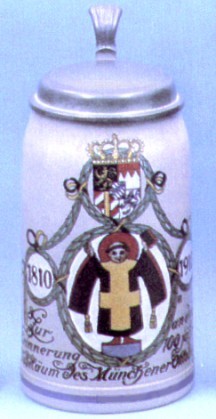 |
| A Franz Ringer stein created for
the Oktoberfest of 1910, and commemorating the wedding of Crown Prince Ludwig
and Princess Therese 100 years earlier |
Part 1 - Oktoberfest, by Jack G.
Lowenstein
(Originally printed in Prosit in September 1984)
It all started in 1810. The wedding of Crown Prince Ludwig (later to become
Ludwig I) to Princess Therese of Saxony-Hildburghausen was planned for October
12. But Emperor Maximilian wanted something special for his son - and a young
soldier, Franz Baumgartner, came up with a good idea: Why not celebrate the
occasion with horse races and other entertainment? The suggestion was accepted
and a large area on the outskirts of Munich was cleared for the events and
renamed in honor of the young bride: Theresienwiese, or Theresien Meadow.
The anniversary of the royal wedding was celebrated annually, but it wasn't
until 1835, the 25th anniversary of Ludwig and Therese, that Oktoberfest became
a weeks-long celebration! The Fest started 2 weeks before the royal anniversary
and came to an extravagant conclusion on October 12. Events included horse
racing, sharpshooting contests, balloon ascensions, exhibitions - and the
consumption of lots of food, especially beer.
Oktoberfest had come into its own!
In the ensuing years, Oktoberfest has been celebrated annually except
for war years. It has become a 16-day-long festival, usually starting on the
next-to-the-last Saturday in September and ending in October. The Weise is
turned into a giant amusement park and beer tent city, each Munich brewer
putting up a giant tent where its beer is served exclusively, together with
sausages, roast chicken, fish, pretzel, red gingerbread hearts and other
goodies. Over 5 million people come to Oktoberfest these days [1984], consuming
some 20 million liters of beer, half a million roasted chickens and some million
pairs of pork sausages.
For you history buffs: The large Bavaria statue on the side of the Theresien
Meadow, in front of the Hall of Fame, was unveiled in 1850. This statue, shown
on many Munich steins, depicts the Lady Bavaria holding the victor's wreath,
with the Bavarian lion at her side.
And yes, the royal wedding of Ludwig and Therese did result in a lasting
peace between the states of Bavaria and Saxony!
This year (1984) will celebrate the 150th Oktoberfest. And next year, the
world's biggest beer bash will celebrate its 175th anniversary: 1810-1985.
Of course, where there's Munich and beer, there have to be beer steins. And
commemorative beer steins there are. The best known Oktoberfest steins are those
commemorating the 100th anniversary, 1810-1910. A large number of these
anniversary steins were produced, probably by just about every stein
manufacturer. Some - but not all - of these steins were stamped on the bottom,
"Offizieller Festkrug - Oktoberfest 1910" or "Official
Festival Stein - Oktoberfest 1910" (below).
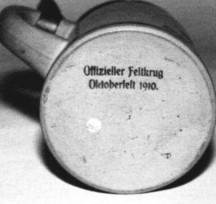 |
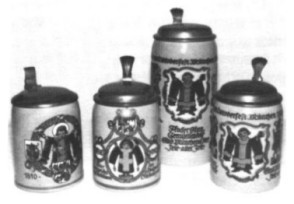 |
| Figure 1 - Official Festival
Stein, 1910 |
Figure 2 - Four Oktoberfest
Commemorative Steins |
The next major anniversary was in 1935, the 125th. More Festival Steins were
produced and sold. Above we see four Oktoberfest steins: The ½-liter steins on
the left are 100th anniversary steins, while the 1-liter Krug and the ½-liter
one to its right celebrate the 125th anniversary. The verse on the latter two
steins perfectly reflects the spirit of the occasion:
Froher Sinn,
Gemütlichkeit
Sind Münchens Art
Seit alter Zeit |
A happy spirit,
and Gemütlichkeit
Are Munich's style
Since olden times |
Fig. 3 shows a rather uncommon stein, the Munich Child sitting on a great
big red heart. No, it's not a Valentine Day's greeting. The heart here is the
large candy, gingerbread or chocolate heart which a young gentleman gives to his
love at Oktoberfest time, to hang around her neck for all to see: A heart for
his dearest sweetheart!
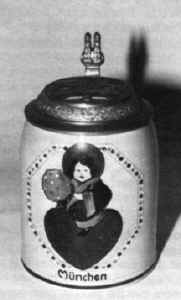 |
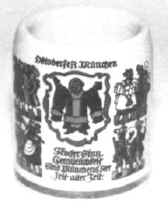 |
Figure 3 - The Munich Child and
an Oktoberfest heart |
Figure 4 - A Modern Oktoberfest
souvenir mug |
Fig. 4 is a modern Oktoberfest mug, on sale at every souvenir stand on the
Oktoberfest Wiese. Note that it reflects the decor of the 125th anniversary
steins.
The next two Oktoberfests should provide ample opportunity for more
collectable steins: This year is the 150th actual Oktoberfest, while next year
will be the 175th anniversary of Ludwig and Therese's wedding and the very first
Oktoberfest. Bring on the chicken; bring on the sausages; bring on the beer: Prosit!
(A gentle hint, dear reader: If you go to the Oktoberfest, do not
walk off with one of the stein used for serving beer in the tents. There is a
heavy fine if you are caught. Instead, buy the steins for just a few Marks - a
sticker will be placed on the stein to show that it is indeed legitimately
yours.)
Part 2 - Oktoberfest in Munich, by A. Chapman, Jr.
(Originally printed in Prosit in September 1976)
The world renowned Bavarian national festival, the Oktoberfest, held
annually on the fairgrounds at Munich, Germany, can only be described in
superlatives. It is absolutely the biggest, noisiest, liveliest and beeriest
concentration of humanity ever assembled on this planet.
It all begins at high noon on the last Saturday in September and runs for
sixteen roaring days. The many acres of the fairgrounds have been set up with
miles of tents and booths featuring games of chance and skill, thrilling rides,
side shows and a stupendous variety of outdoor cooking. The daily menu features
charcoal grilled chickens, sausages in all their varieties, grilled fish spiked
on sticks, whole oxen roasted on the spit over a pit of live coals and the ever
present sandwich and pretzel stands.
Entrance is free and each year some five million people from all over the
world are attracted to this fun fair of gigantic abundance. The tantalizing
odors of outdoor cooking and cheerful jollity will long remain in the heart and
memory of these millions.
However it is the seven huge tents, each the size of a Ringling Brothers big
top, erected on the fairgrounds by Munich's seven principal breweries, which may
be said to be the true heart and soul of the Oktoberfest.
It is here that a strong and specially brewed "Weisn Bier"
is sold at a price now approaching a dollar and a half a liter, and which is
drawn pre-cooled directly from large wooden barrels. In the not too distant
past, the beer was served in one liter salt glazed stone mugs, locally called a
"Mass Krug", but today at the Fest, the beer is usually served
in heavy one liter thumb print pressed glass mugs. A favorite sport of the
patrons (in spite of signs warning to the contrary conspicuously posted in
several languages) is to attempt to sneak one of these Fest mugs out of the tent
past the eagle eyes of the ever present uniformed "bouncers" who take
a very dim view of such activities and are apt to react most harshly with would
be souvenir collectors.
With as many as five foaming mugs in each hand, cheerful, buxom waitresses
in colorful Bavarian costumes, jostle through the crowds keeping a steady stream
of cold beer flowing from the barrels, located at several places on the
perimeter of the tent. to some five thousand thirsty revelers seated at long
plank tables. Hawkers criss-cross the floor with offers of comic hats, chocolate
hearts (a must for the ladies), postcards, and souvenir beer mugs with the
emblem of the tent's sponsoring brewery. Mugs which have been honestly purchased
at the Fest have a paper seal attached to the handle, which allows the new owner
to remove his prize from the tent without any "reaction" from the
management.
In the late afternoon of each day, a fifty piece Bavarian brass band comes
forth onto a stage centered in each tent, and for the next five of six hours,
the tent rocks and sways to the beat of marches, waltzes, polkas and old German
drinking songs. As soon as a tune starts from the bandstand, the words and music
are at once picked up first by one table and then another until some five
thousand singing revelers, locked arm in arm and swaying to the music, burst
forth in one pleasing sound. By mid-evening the scene in a beer tent can only be
described as utter Bedlam - a scene which it is said could only be adequately
described to an outsider by the brush of a Hogarth and the pen of a Dickens.
"You just gotta see it to believe it!"
And it all ends at eleven o'clock on the night of the third Sunday, the
sixteenth happy day. The band sadly and slowly plays "Auf Wiedersehen";
the standing enthusiasts give forth with one long whistle, a last cheer, and
another Oktoberfest passes into history. Everyone files out of the tents, across
the fairgrounds and heads for home with the feeling that he has contributed his
all to the greatest Oktoberfest ever. But then, there will always be another
year and another Oktoberfest, which might even be bigger and better than the one
which has just been brought to such a successful end.
Part 3 - The Statistics (from the Munich Tourist Office web site)
The attendance at Oktoberfest is about 6.5 million people. In 1999,
Fest-goers consumed over 600,000 chickens, 150,000 pairs of pork sausages,
62,000 pork knuckles, 16,000 kg fish and 84 oxen. Beer consumption reached a new
high with over 6 million liters being quaffed. Other drink preferences included
wine (almost 31,000 liters), sparkling wine (almost 24,000 bottles), water and
lemonade (444,000 bottles) and coffee or tea (198,000 cups). Munich's great
"block party" makes all others pale by comparison.
© Stein Collectors
International 1996-2014
All rights reserved.
|





